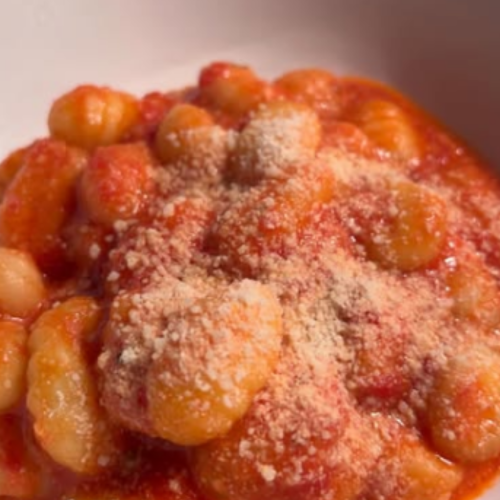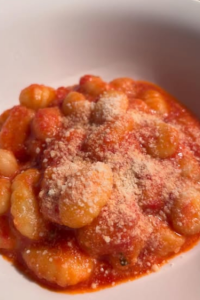Method:
Cook the Potatoes:
Start by peeling and quartering the russet potatoes. Place them in a large pot of water, bring to a boil, and cook until they’re fork-tender (around 15-20 minutes). Once cooked, drain and let them cool slightly.
Rice the Potatoes:
After they have cooled enough to handle, use a potato ricer or masher to mash the potatoes. Ensure they are smooth with no lumps. Avoid using a regular masher if possible, as it can leave chunks that will make the gnocchi dough uneven.
Make the Dough:
On a clean work surface, place the riced potatoes and make a well in the center. Crack the egg into the well, add a pinch of salt, and slowly mix in the flour until the dough starts coming together. You want the dough to be soft and slightly tacky but not too sticky.
Shape the Gnocchi:
Once the dough is ready, divide it into sections and roll each section into a long, thick rope. Using a sharp knife or bench scraper, cut the dough into small, bite-sized pieces, about 1 inch (2.5 cm) in length. If you have a gnocchi board, use it to create the traditional ridges by rolling each piece over the board with your thumb.
Boil the Gnocchi:
Bring a large pot of salted water to a rolling boil. Drop the gnocchi into the water in small batches. When they float to the surface, wait an additional 15 seconds before removing them with a slotted spoon.
Serve and Enjoy:
You can serve gnocchi in a simple tomato sauce, a rich ragu, or even a butter-sage sauce. Grate fresh Parmigiano Reggiano over the top for an added touch of indulgence.
Tips and Variations:
Potato Type: Use starchy potatoes like russets for the best texture. Avoid waxy potatoes as they will make the dough too soft.
Flour: Some recipes use 00 flour, but all-purpose flour works just fine and is often easier to find.
Freezing: Gnocchi freezes well! If you make a large batch, freeze the uncooked gnocchi on a baking sheet and transfer them to an airtight container once frozen. Drop them straight into boiling water when you’re ready to cook.
Vegan Version: If you want a vegan version, you can skip the egg, but keep in mind that the texture might change slightly. You may need to adjust the flour amount for consistency.

